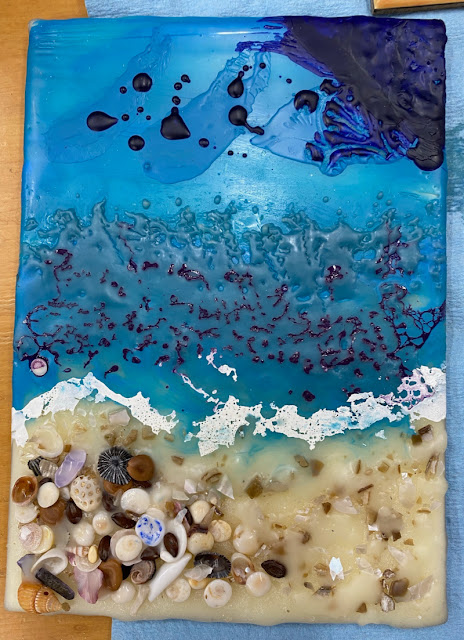What is Beeswax Encaustic and What are Some of the Supplies Used in Deborah Stachowic's Beeswax Encaustic Collage and Painting Classes
 |
| Deborah Stachowic applying beeswax encaustic |
Beeswax encaustic collage and painting involves a lot of creative play and experimenting which is why Deborah’s classes are fun for both the “not artistic at all” and for accomplished artists from other mediums!
 |
| 2 student beeswax encaustic artwork from Deborah's classes |
Painting with encaustics has a long history, it began as an art medium about 100 AD in Egypt for mummy portraits, and before that the Greeks used encaustic to waterproof and decorate their ships. Deborah’s classes focus more on the process of creative play and combining papers with assorted objects and fusing them with hot beeswax into mixed media collages. Because beeswax is moisture proof it helps protect and preserve the artwork, which is why the mummy portraits are still vivid and beautiful after nearly 2,000 years!
The mixed media collages students create in Deborah’s classes are often very meaningful when collaging with materials that are connected to personal experiences producing memory or memento collage art. The collages can also be simply reacting to the process and materials to create artwork that is beautiful and unique! Because of the special tools (hot palette, heat gun, propane torch etc.) necessary to work with beeswax encaustic, it’s not as easily accessible as other art mediums are, and why taking a class is a great way to learn the basics and try it out. Deborah provides the special tools and more during her classes along with teaching how to work with encaustics and sharing many tips and techniques. .
 |
| Some tools for encaustic: hot palette, heat stylus & gun plus blow torch |
Color is highly expressive, and similar to oils, acrylics and watercolors, beeswax encaustic can be modified with pigments and mixed into a wide range of colors, including your favorites! Soft or vivid colors, and the wonderful range in between can be created through the choice of wax pigments and powders as well as other materials like crayons, oil paint sticks, and oil pastels among others, as well as the ratio of pigment to wax. Color choice is personal and conveys so much to the viewer and is an important component to all forms of painting including encaustics, plus the beeswax gives the colors a beautiful glow that is so warm and appealing.
Deborah will have lots of things, paper etc. to use for collaging in her classes, and it’s a good idea to bring additional items that you think you would like to use for creating your encaustic artwork. This is especially important if you are interested in making memory or memento collages.
What you need to know and bring to your first beeswax encaustic class with Deborah Stachowic
Some examples of materials that can be used when collaging with beeswax encaustics
Below are some ideas for collaging materials that you may want to bring.
Papers:
[Tip for papers - especially photos, make a copy rather than use the original plus you can add color with markers etc.]
Japanese decorative papers.
Wrapping papers.
Drawing or other art papers with drawings, or stamped images.
Copy paper with images, words, phrases or poems.
Copies of photos (glossy photos may resist the wax).
Wallpaper.
Newspaper.
Magazines.
Old tickets or other paper memorabilia.
Cards and postcards.
Envelopes.
Stamps.
Fabric, trims and other sewing materials:
Lace and other trims.
Embroidery threads.
Ribbon.
Buttons.
Textural things:
[Note: natural materials must be dry, nothing with moisture]
Sand and small stones.
Bark, small twigs.
Dried or silk flowers and leaves.
Dried grasses, seeds and pods.
Small metal objects like keys etc.
Jewelry.
Game pieces like Scrabble letters or playing cards.
There are so many things that you can use when creating Beeswax Encaustic Collages, this list is just some ideas! We're sure you'll have some great ideas of your own!
We hope to see you in one of Deborah Stachowic's Beeswax Encaustic Classes!
To find out more about Beeswax Encaustic,
please visit the Waxing Impressions Blog Article Index for a list of articles.
Find Waxing Impressions on Facebook
see other students beeswax encaustic artwork!
If you would like to receive Deborah's email Newsletter
with information on upcoming events as well as
Deborah's journey creating an Art Workshop School in Italy at her
new Umbria countryside home (a former airbnb) for 2023,
please email Deborah at
WaxingImpressions@yahoo.com
and ask to be added to her email Newsletter.
The Art Workshop School will have guest art instructors
teaching a wide variety of art mediums in addition to
the workshops Deborah will be teaching in Italy!
.








Comments
Post a Comment